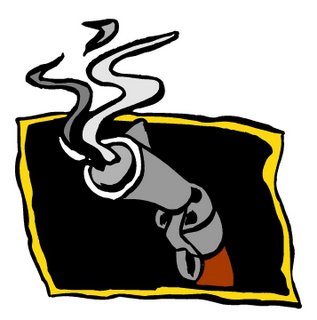
While Canada takes the high road on small arms in conflict areas, Canada Seeks Treaty To Prevent Illicit Flow Of Small Arms To Conflict Areas it has also benefited from the boom in small arms demand since 1990. Go figure. It's called war profiteering. Which will only increase under the New Conservative Government which has close connections with the Military Corporate Complex.
It also reflects Canada's views on gun control, which under the Harper government may mean not only a change in our domestic policy but our international policies as well.
Foreign Affairs Minister Peter McKay would not answer the oppositions question about the governments position on the UN Treaty.Small Arms and Light Weapons A simple yes or no question. As usual.
Campaigners for a new international Arms Trade Treaty have noted with disappointment that Canada has yet to endorse a UN resolution, expected to go to vote next week, to start work on the new Treaty.
According to the above story the Government of Canada has now added its official signature as a sponsor of the the Treaty. Now that wasn't so hard, why all the obfustication? Because it is contradictory for the New Canadian Government to want to dismantle the gun registry on one hand and to promote this small arms treaty on the other.
A discussion of gender is relevant to understanding the effects of violence as well as its causes, in conflict and in peace, and particularly where small arms are concerned. While small arm casualties among women and children are significant both in war and in “peace”, the vast majority of victims of gun violence world-wide are men. At the same time, women are targets of certain types of violence as a result of their gender. Moreover, some forms of violence against women are unique and an understanding of these dynamics is the key to effective intervention. For a variety of reasons, small arms ownership and use are predominantly male enterprises. A disproportionate percentage of the aggressors (whether in conflict or in peace) are male, while a significant proportion of victims are women. In other words, the percentage of women victimised by the misuse of small arms is greater than the percentage of small arms misuse by women. Sociological perspectives have focused attention on militarized cultures that are both a cause and an effect of the proliferation and misuse of firearms. The political processes at the national and international level are dominated by men who bring certain perspectives to small arms. As one Canadian Senator noted during a heated debate on domestic firearm regulation: "if there were more women in Parliament, we would not even be having this debate". The way in which expertise is defined (e.g. technical knowledge of the weapons themselves rather than knowledge of violence or conflict prevention) also shapes the way in which the issue is addressed. However, women have played critical roles throughout the world in successful community-based and advocacy efforts to address the problem. Many of these efforts have involved building coalitions that bring together players from across various sectors. The problems associated with the proliferation and misuse of small arms is a women's issue, but not exclusively so. Indeed, mobilizing women is critical to devising and evaluating strategies to reduce these problems. The gender lens provides a unique perspective which crosses traditional boundaries that encourage dichotomies such as crime/conflict; licit/illicit; north/south; domestic/international. It promotes an integrated and holistic approach to the problem of small arms that includes addressing both demand and supply. The regrettable truth is that women are often as much at risk of violence from small arms in contexts described as peaceful as they are in conflicts. Women are as much at risk from licit small arms as from illicit small arms. In terms of improving the safety of women and children from small arms, measures aimed at strengthening control over civilian possession of small arms in order to reduce diversion and misuse are as critical as those aimed at strengthening controls over state to state transfers or imports and exports. Consequently, a gender analysis reinforces the need for an integrated and holistic plan of action arising from the 2001 conference.
CONFLICT, PEACE-BUILDING, DISARMAMENT, SECURITY Gender Perspectives on Small Arms
Small Arms and Light Weapons
A multitude of studies and reports conducted since the end of the Cold War show conclusively that the excessive and destabilizing accumulation and uncontrolled spread of small arms and light weapons has posed and continues to pose a major threat to international peace and security. In virtually all conflicts that have erupted since 1990 the principle or exclusive weapons system used have been small arms and light weapons.
Canada and Small Arms Exports
According to the Small Arms Survey (2005), Canada is a “major” small arms exporter because it typically exports more than US $10-million in small arms and ammunition a year. At the same time, Canada is not among the “top exporters” identified in the 2005 Small Arms Survey (p. 100): the United States, Italy, Brazil, Germany, Belgium, the Russian Federation, and China.
Canadian exports of military small arms are reported by the Canadian government in its Annual
Report on the Export of Military Goods. To date the Annual Report has provided data on the export of goods specifically designed or adapted for military use, including a category—Item 2001—for military small arms. This item was defined in the most recent Annual Report as “firearms and automatic weapons with a calibre of 12.7 mm (0.5 inches) [or less], including firearms for sporting and competition purposes and their components and accessories.” 2 The category includes rifles, carbines, revolvers, pistols, shotguns, and machine guns.
As illustrated by Figure 1, in the last decade of reported data (1993-2002) the value of these exports has fluctuated dramatically, from a low of less than $1-million in 1993 to a high of more than $30- million in 1995. The spikes in military small arms exports have corresponded to concentrated shipments of Canadian-manufactured automatic weapons to NATO countries, including the Netherlands, Denmark, Norway, and the UK. The total value of shipments for the 10-year period is $143-million or an average of over $14-million per year. The totals of Figure 1 are incomplete, however, for two reasons. First, exports of military small arms and light weapons to the United States are not included because special military trade arrangements between Canada and the US do not require the usual government tracking and reporting of military goods. Second, the totals shown are for the firearms and automatic weapons category of Canada’s Export Control List (ECL Item 2001) and do not include the light weapons and small arms ammunition that are included but not reported separately in other military goods categories. Consequently, the true values of Canada’s annual military small arms exports are higher than the reported figures.
The Military Lobby
While much smaller but no less successful than the corporate lobby, the military lobby comprises corporations that produce goods or provide services to the Department of National Defence, the Pentagon, other foreign governments, parent corporations and prime contractors. They benefit from military contracts, and federal and provincial subsidies and tax breaks.
A strong element of the military lobby is bonded by ideology (with some self-interest thrown in). These are the pro-defence "think tanks" such as the Conference of Defence Associations or the Security and Defence Forum that links largely hawkish academics from a dozen universities together through common interests and a $2-million fund from the military.
On the industry side, the Canadian Association of Defence and Security Industries reports that in 2000 (the latest figures available) there were more than 1,500 firms in Canada generating more than $100,000 in defence revenues, comprising an industry worth roughly $7 billion per year.
A third of the industry's revenues are derived from arms exports, half of that to the United States. As a result, both the Washington-based Congressional Research Service and the Stockholm International Peace Research Institute ranked Canada as the sixth largest global arms exporter in 2004.
These companies build everything from wheeled tanks to tactical helicopters. But most Canadian defence companies are branch plants or subcontractors, building components for U.S. systems, such as gearboxes for the Apache helicopter.
Even the top Canadian companies realize a small share of their revenue from military contracts. According to Project Ploughshares, the industry is dominated by a handful of companies who typically land on the list top 10 Canadian military contracts: CAE Inc., General Dynamics Canada and General Dynamics Land Systems Canada, SNC-Lavalin Group, Bell Helicopter Textron, Bombardier. Half of the top 10 companies are foreign owned or controlled. Yet only six of the top 10 companies actually rely on military contracts for more than 20 per cent of their revenue.
Finally, one cannot exclude the Department of National Defence itself from the military lobby. It spends millions of dollars a year on public relations, including public opinion polling, cultivating favorable coverage from journalists, in addition to funding conservative think tanks and university research institutes.
Canadian Small Arms Industry & Products
The following information was compiled by Project Ploughshares from open sources.
Small Arms Manufacturers|Ammunition|Components
Diemaco Inc., Kitchener, Ontario
Designated the Small Arms "Centre of Excellence" by the Canadian Department of National Defence, Diemaco was proclaimed to be "the firearms-production capital of Canada" when it received a C$107 million contract from the Defence Department to supply automatic rifles and carbines in 1984. In 1994 the company landed a C$50 million contract with the Netherlands military to supply C7 rifles, followed in 1995 and 1996 by Danish orders worth C$13 million. Diemaco also has exported automatic weapons and components to Belgium, New Zealand, and the United States, according to company and media reports, and it has had additional "export experience" in Australia, Papua New Guinea, Saudi Arabia, and the United Kingdom, according to Industry Canada [source: Industry Canada, "Canadian Company Capabilities"].
Diemaco produces the C7 Combat Rifle (a version of the US Colt M16), the C7A1 Combat Rifle (an optically-sighted version of the C7), the C8 Carbine (a C-7 with a telescoping stock and a shorter barrel), and the C10 training rifle. The company is a division of Devtek Corporation, based in Markham, Ontario.
From 1981 Diemaco lobbied the government to change the Criminal Code so that it could export automatic rifles, contributing to 1991 legislative changes creating an Automatic Firearms Country Control List of prescribed countries eligible to order automatic weapons from Canada.
Para-Ordnance Manufacturing Inc., Scarborough, Ontario
Para-Ordnance manufactures and sells handguns -- a range of 9mm, .40- and .45-caliber pistols. According to company material, Para-Ordnance is the originator of the "high magazine capacity" .45-caliber pistol, and "offers a wide range of quality engineered products for the law enforcement, military, and civilian markets" [source: "About Us" from the company website]. Para-Ordnance supplies domestic customers, including Canadian police forces, private sports shooters and hunters, and ships handguns out of the country, reporting export sales exceeding C$500,000 in a company report to Industry Canada in 1998. In 1996, Para-Ordnance received an export permit to sell about 200 handguns worth just over C$100,000 to police in Thailand, according to media reports. The company also claims "export experience" in over 20 countries, including South Africa, Philippines, Argentina, Chile, Venezuela, and all states in the United States.
Savage Arms (Canada) Inc., Lakefield, Ontario
Savage Arms (Canada) produces .22-caliber long rifles and sporting fire rifles, including those used for target shooting and biathlon events. Formerly the Canadian-owned Lakefield Arms, the company is now a subsidiary of the Massachusetts-based Savage Sports Corporation. According to company officials, Savage Arms exports 97 per cent of its rifles, mostly to the US. [source: testimony of Mr. Barrie King, Vice-President and General Manager, to the House of Commons Standing Committee on Justice and Legal Affairs, 24 November 1997]
Armament Technology, Halifax, Nova Scotia
Armament Technology sells Canadian-assembled 7.62 mm tactical and sniper rifles to military, police and civilian customers. The Canadian-owned company also distributes associated firearms equipment such as optical sights and rifle stocks and provides refits, including rebarreling, of police and military sniper rifles. Armament Technology has reported sales to Canadian and US police forces as well as exports to Australia.
Additional Ontario businesses involved in "manufacture, processing or assembly of firearms"
Marstar Canada Inc., VanKleek Hill
Phantom Forge, Shelburne
Precision Arms & Gunsmithing Ltd., King City
Stoeger Canada (1990) Limited, Whitby
United Sport Shooting Ranges, Gormley
[source: Chief Firearms Office of Ontario]
Small Arms Ammunition Manufacturers
SNC Industrial Technologies Inc., Le Gardeur, Quebec
A division of the SNC-Lavalin Group of Montreal, SNC Industrial Technologies produces a range of small arms ammunition, including 5.56 mm, 7.62 mm, 9 mm, .50- and .303-caliber rounds as well as small arms training ammunition for military, special forces, and police in Canada and abroad. The Canadian Department of National Defence is the company’s largest customer by far, awarding regular multi-million dollar orders for small arms ammunition. (In 1996, for example, the Department of National Defence placed a C$180 million order for "ammunition through 30 mm" with the company.) SNC has also exported training ammunition to the US Navy and Army, the US Federal Bureau of Investigation, and the French Ministry of Defence. In reports to Industry Canada, the company cites "export experience" with over 30 other countries, including Albania, Armenia, Azerbaijan, Ecuador, Oman, Russia, Thailand and the former Yugoslavia. SNC Industrial Technologies also has supplied 81 mm mortar cartridges and, before 1992, "Elsie" anti-personnel landmines to the Canadian Army.
Royal Canadian Cartridge and Munitions Corp., North Vancouver, British Columbia
Royal Canadian Cartridge and Munitions produces shotshells, .22-caliber rimfire rounds, and other small arms ammunition. It is a Canadian-owned company.
Challenger Ammunition, Sainte-Justine-de-Newton, Quebec
Challenger Ammunition produces shotshells, and firearms ammunition, including bullets, and centrefire and rimfire rounds. According to Industry Canada, the company reported no export sales, although it is "actively pursuing" many foreign markets.
Wolf Bullets, Kingston, Ontario
According to promotional material, the company manufactures lead bullets and remanufactures handgun cartridges.
Expro Chemical Products Inc., Salaberry-de-Valleyfield, Quebec
Expro manufactures military and commercial propellants and explosives, including explosives used in small arms weapons and ammunition. These include Cyclotol used in grenades, special fragmentation projectiles, and shaped-charge bombs, RDX, used in landmines, and M9 flake explosive used in mortars. The company’s largest military customers are DND and the US Army. The company reports "export experience" with 11 other countries, including Mexico, Philippines and Turkey, although these may have been commercial orders. Expro is one-third owned by its employees.
Small Arms Component Manufacturers
ELCAN Optical Technologies, Midland, Ontario
ELCAN produces optical sights for military small arms use, including sights with night vision capability. The company, now a division of the US-based Raytheon Systems Company, also produces optical systems for mortars and the Eryx anti-tank weapon. ELCAN has sold thousands of sights to the Canadian military-–in 1992 the Department of National Defence ordered 6,750 optical sights worth C$5 million for C9 light machine guns and 55,000 sights worth C$20 million for C7 combat rifles. Additional military customers include Australia and the UK. In 1998 the US Army ordered ELCAN telescopic sights for 5.56 mm and 7.62 mm machine guns in an initial C$200,000 order that could lead to sales totalling C$6 million.
The ERYX Short-Range Anti-Tank Guided Weapon System - Canadian components
As part of a 1993 Department of National Defence contract with Aerospatiale Missiles of France for Eryx short-range missiles, the Canadian government obtained offset arrangements that provide for Eryx component production in Canada. The Eryx anti-tank system, which is "man portable" and can be shoulder-launched, was subsequently ordered by Brazil, France, Malaysia, Norway, Turkey and an "undisclosed member of the Gulf Co-operation Council" in the Middle East. [source: Jane’s Defence Weekly, 14 April 1999, p.18]
The Canadian subcontractors consist of:
Allied-Signal Canada Inc, Montreal, Quebec (joint production with Thomson TTD Optronique, France of the Mirabel Thermal Imager);
Composites Atlantic Limited, Lunenburg, Nova Scotia (firing post tripods);
Canadian Marconi Company, Ville Saint-Laurent, Quebec (hybrid electronic circuits);
Amptech Corporation, Calgary, Alberta (plastic components).
Click here to view a table of small arms producing companies in Canada.
See:
Foreign Aid Or War Profiteering
Canada War Profiteers
Find blog posts, photos, events and more off-site about:
UN, Canada, Peter, McKay, Harper, Conservatives, Government, Ottawa, MP, military-indusrial-complex, politics, war, parliament, weapons, manufacturing, bullets, , small-arms, treaty, conflict-zones, gender, gun-control,









